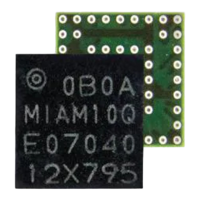MIA-M10Q-Integration manual
Feature Change Action needed / Remarks
Galileo return link message Galileo search and rescue (SAR) return link message UBX-
RXM-RLM.
Code change (optional)
RF spectrum view New message. UBX-MON-SPAN shows in-band RF
spectrum around the GNSS band. This can be used to
identify potential in-band RF interference sources in the
design.
Code change (optional)
Location batching New feature that can be used to reduce power
consumption by saving navigation solutions on the
receiver for up to 10 minutes (at 1 Hz) and polling the
solutions afterwards to a host MCU.
Code change (optional)
Protection level New feature. Real-time position accuracy estimate with
95% confidence level with the message UBX-NAV-PL.
Code change (optional)
Security
Message integrity New feature. Authentication of data output based on
private/public key pair.
Code change (optional)
Unique chip identifier A unique chip identifier output in boot screen and in the
UBX-SEC-UNIQID message.
Code change (optional))
Configuration lock New security feature that is enabled with CFG-
SEC-CFG_LOCK message for locking the receiver
configuration.
Code change (optional)
Table 33: MIA-M10Q software features
Refer to the firmware Release notes [2] and the Interface description [3] for more information on
supported features and messages in u-blox M10 receiver.
B Reference designs
This section provides some reference designs for typical and antenna supervisor design cases.
Designs with 1.8 V main supply or with independent supply for VCC and V_IO must fulfill
certain requirements when transitioning to hardware backup mode. Refer to Supply design
examples for more details.
B.1 Typical design
Here are some key features for a MIA-M10Q typical design:
• VCC and V_IO are connected together to a single supply. In designs with 3.3 V supply, the VIO_SEL
pin must be left open, as shown in Figure 35. In designs with 1.8 V supply, the VIO_SEL pin must
be connected to GND, as shown in Figure 36.
• V_BCKP supply is optional. If present, the hardware backup mode is supported. This mode
maintains the time and GNSS orbit data in the battery-backed RAM memory if the main supply
is switched off.
If there is no backup supply, the EXTINT pin can be used for time aiding and the GNSS orbit data
can be aided using AssistNow services or downloaded to the host and fed back to the receiver
at startup.
• RTC is optional, and it is only needed if one of the backup modes or PSMOO is used. If neither of
these modes are used, the RTC can be dropped. In that case, the RTC_O pin must be connected
to GND.
• A passive or active antenna can be used. An active antenna can be supplied either with the
VCC_RF output from MIA-M10Q, as shown in Figure 37, or from an external supply, as shown in
Figure 38. Nevertheless, the internal LNA provides enough gain for passive antennas.
• MIA-M10Q has an internal SAW filter and no additional RF front-end components are needed.
However, in cellular applications, an external SAW filter can be added in front of RF_IN as shown
UBX-21028173 - R01
Appendix Page 80 of 89
C1-Public

